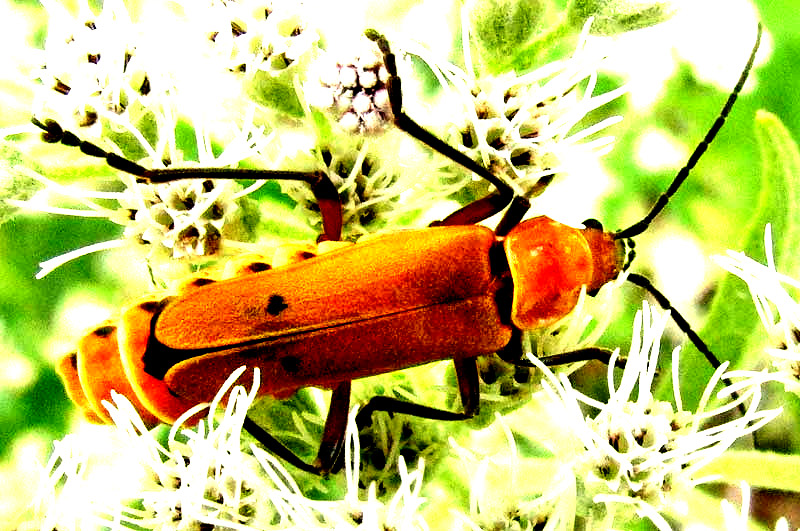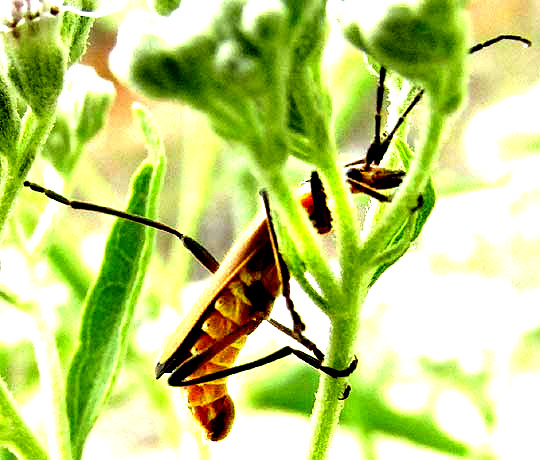Excerpts from Jim Conrad's
Naturalist Newsletter

from the September 14, 2014 Newsletter issued from the Frio Canyon Nature Education Center in the valley of the Dry Frio River in northern Uvalde County, southwestern Texas, on the southern border of the Edwards Plateau; elevation ~1750m (~5750 ft); N29.62°, W99.86°; USA
SOLDIER BEETLE
Nowadays late-summer and fall wildflowers are starting to flower, and among the most noticeable is the Lateflowering Boneset, Eupatorium serotinus, a shoulder-high member of the Composite or Daisy Family, with basketball-size heads of white, very fragrant compound flowers. The odor is like honey with a touch of freshly cut hay field in it. You poke your face down among the blossoms and you almost swoon from all the perfume. Of course butterflies and other insects are drawn to the flowers in large numbers. Among them at this season is a certain soldier beetle with a dark spot on each of its long, hard outer wings, or elytra (singular elytron). Above, you can see a very satisfied looking soldier lounging amidst all the flowers' slender, tickling style arms and the heady perfume and sweet nectar.
A view from the side of a nearby beetle is shown below:

Past experience shows that soldier beetles can be hard to identify, but volunteer identifier Bea in Ontario managed to cut down possibilities to the genus Chauliognathus, of which about 19 species are listed for North America. Of those, Bea thought it was one of two species, but wouldn't say which. It especially looked like Chauliognathus discus, but the pictures she found of that species lacked the dark spots on their elytra.
In reading about the species, however, a quote from K.M. Fender's "The Chauliognathini of America North of Mexico" turned up saying about Chauliognathus discus that the "Size of subapical elytral spots varies from immaculate to apical third of elytra being black." In other words, to be Chauliognathus discus, having spots is OK, and they can even have the whole end third of their outer wings black.
CHAULIOGNATHUS DISCUS is listed for Texas and New Mexico, but mostly is a Mexican beetle, occurring at least as far south as south-central Mexico. The species isn't known well enough to have its own common name, so it's just referred to as "Soldier Beetle," along with several other Chauliognathus species.
Just to enjoy the esthetic buzz of seeing "a variation on the soldier beetle theme," you might enjoy comparing our above picture with another soldier beetle found in our area, Chauliognathus scutellaris, at http://www.backyardnature.net/n/14/140517bt.jpg.
Soldier beetle adults typically are found on flowers, especially Composite Family members, where they mate and feed on pollen and nectar. The larvae range along the ground or among debris feeding mostly on eggs or larvae of other insects. Adults normally are seen in summer and early fall and the various species are mostly distributed in eastern North America.
It's said that the name soldier beetle derives from some of the species being red and black, like certain early military uniforms.